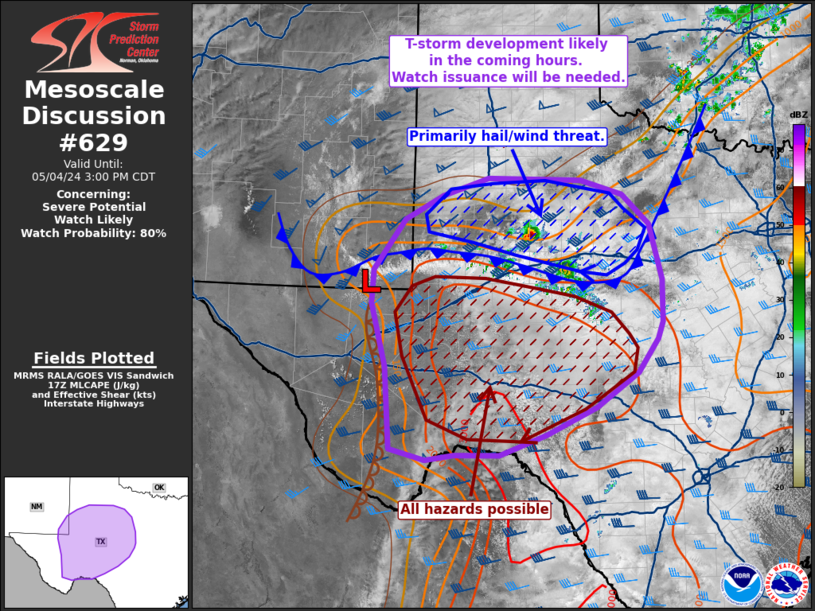|
|
| Mesoscale Discussion 629 | |
| < Previous MD | |

|
|
Mesoscale Discussion 0629
NWS Storm Prediction Center Norman OK
1236 PM CDT Sat May 04 2024
Areas affected...West to southwest Texas
Concerning...Severe potential...Watch likely
Valid 041736Z - 042000Z
Probability of Watch Issuance...80 percent
SUMMARY...Thunderstorm development along a southward-surging cold
front is likely within the next 1-2 hours with additional convection
expected later this afternoon across southwest TX. Given a favorable
environment for organized severe convection, one or more watches
will likely be needed in the coming hours.
DISCUSSION...Transient convection, along with a more robust cell
near Snyder, TX, is noted along and just behind a surface cold front
per regional radar and GOES visible/IR imagery at around 17:30 UTC.
Aside from the Snyder, TX cell, this convection has been short-lived
so far, likely owing to rapid displacement of initial updrafts onto
the cool side of the boundary. The development of additional
deep/robust convection is probable in the next couple of hours as
the downstream air mass continues to destabilize. Initial cells will
continue to be displaced along/behind the boundary given
boundary-parallel mean flow and post-frontal deep-layer shear
vectors. However, MUCAPE within the post-frontal air mass coupled
with elongated hodographs should support a few more intense storms
capable of large to very large hail.
Further south ahead of the cold front, RAP mesoanalyses suggests
MLCIN is slowly eroding. However, convective initiation appears less
imminent based on latest visible imagery trends. Morning CAM
guidance suggests thunderstorm development along/ahead of the
dryline is most probable during the 18-21 UTC period closer to peak
diurnal heating and as modest ascent ahead of an approaching upper
wave overspreads the region. Thunderstorms developing within the
warm sector (most likely off the Davis Mountains where shallow
cumulus is beginning to develop) will likely evolve into high-based
supercells with a risk for large to very large hail. The tornado
risk is expected to increase through late afternoon and early
evening as cells migrate eastward into an increasingly moist air
mass with strengthening southeasterly winds (which should bolster
effective SRH to around 150 m2/s2).
Given these two regimes, a severe thunderstorm watch will likely be
needed for locations north of the cold front with a tornado watch
required for areas south of the boundary. Convective trends along
the cold front and dryline/higher terrain will continue to be
monitored to determine exact timing of either watch issuance.
..Moore/Smith.. 05/04/2024
...Please see www.spc.noaa.gov for graphic product...
ATTN...WFO...FWD...EWX...SJT...LUB...MAF...
LAT...LON 29670283 29820339 30930348 31810370 32270368 32960318
33290257 33530184 33490034 33299967 32899924 32139904
31559905 31329913 30869945 30390011 30010091 29740166
29730237 29670283
|
|
|
Top/All Mesoscale Discussions/Forecast Products/Home |
|


